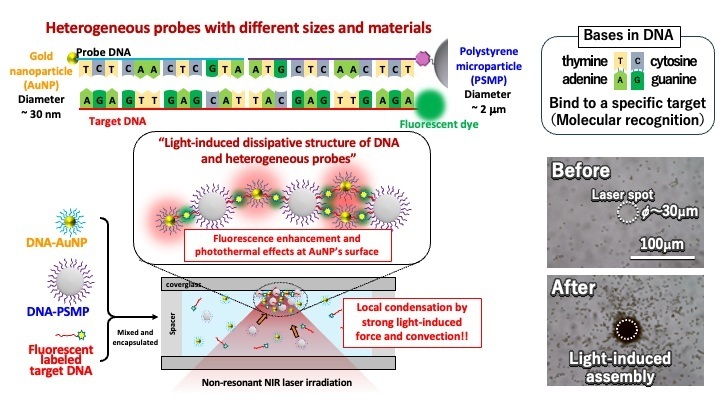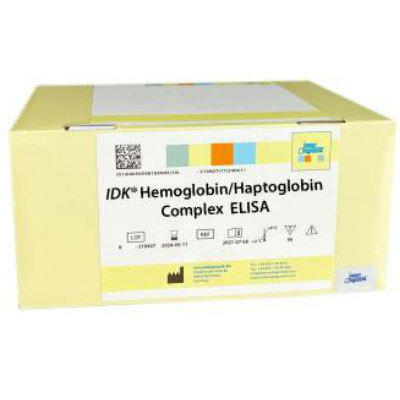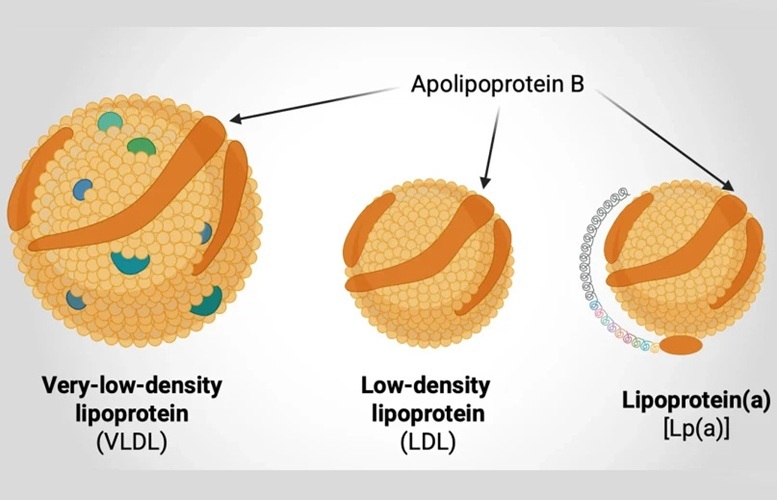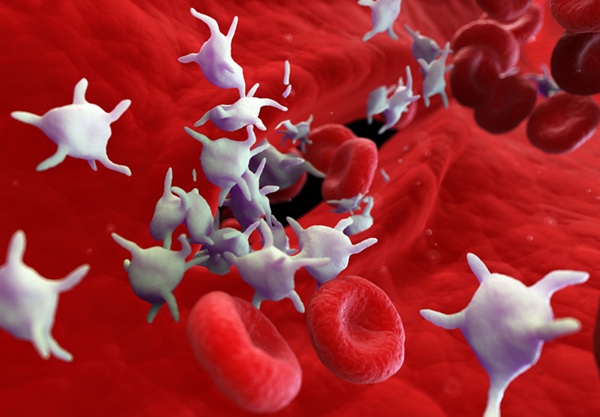Gene Panel Predicts Disease Progession for Patients with B-cell Lymphoma
|
By LabMedica International staff writers Posted on 28 Oct 2019 |

Image: A micrograph of a diffuse large B cell lymphoma (DLBCL) (Photo courtesy of Wikimedia Commons).
Cancer researchers developed a 29 gene–based weighted prognostic score for predicting event-free survival and overall survival of patients suffering from diffuse large B-cell lymphoma (DLBCL).
DLBCL is the most common type of non-Hodgkin lymphoma, an aggressive cancer that begins in certain immune system cells and can occur almost anywhere in the body. This cancer occurs primarily in older individuals, with a median age of diagnosis at approximately 70 years of age, although it can also occur in children and young adults in rare cases. An elevated level of circulating cell-free DNA (cfDNA) has been associated with tumor mass and poor prognosis in DLBCL, but the tumor-specific molecular alterations in cfDNA with prognostic significance have remained unclear.
To help clarify this issue, investigators at the University of Chicago Medical Center (IL, USA) studied the association between 5-hydroxymethylcytosines (5hmC), a mark of active demethylation and gene activation, in cfDNA from blood plasma and prognosis in newly diagnosed DLBCL patients.
The investigators emplyed the 5hmC-Seal, a highly sensitive chemical labeling–based sequencing technology, to profile genome-wide 5hmC in cfDNA from blood plasma of 48 patients with newly diagnosed DLBCL. This technology used the T4 bacteriophage beta-glucosyltransferase to transfer an engineered glucose moiety containing an azide group onto the hydroxyl group of 5-hmC. The azide group could be chemically modified with biotin for detection, affinity enrichment, and sequencing of 5-hmC–containing DNA fragments. The 5hmC-Seal technology was shown to be a robust profiling approach for enriching and quantifying 5hmC-modified DNA fragments with as little as one to two nanograms of cfDNA in less than five milliliters of plasma.
The investigators tested the hypothesis that 5hmC profiles in cfDNA at the time of diagnosis reflected the clinical characteristics of DLBCL and were associated with survival. Results obtained during the study enabled the development of a 29 gene–based weighted prognostic score for predicting event-free survival and overall survival.
“Our findings, if validated in a larger independent patient population, could impact the cure rate for DLBCL,” said first author Dr. Brian Chiu, associate professor of epidemiology at the University of Chicago Medical Center. “By identifying those patients who are at high-risk of treatment failure, we can see who may benefit from individualized clinical management or earlier treatment with novel or targeted therapies.”
The study was published in the October 8, 2019, online edition of the journal Blood Advances.
Related Links:
University of Chicago Medical Center
DLBCL is the most common type of non-Hodgkin lymphoma, an aggressive cancer that begins in certain immune system cells and can occur almost anywhere in the body. This cancer occurs primarily in older individuals, with a median age of diagnosis at approximately 70 years of age, although it can also occur in children and young adults in rare cases. An elevated level of circulating cell-free DNA (cfDNA) has been associated with tumor mass and poor prognosis in DLBCL, but the tumor-specific molecular alterations in cfDNA with prognostic significance have remained unclear.
To help clarify this issue, investigators at the University of Chicago Medical Center (IL, USA) studied the association between 5-hydroxymethylcytosines (5hmC), a mark of active demethylation and gene activation, in cfDNA from blood plasma and prognosis in newly diagnosed DLBCL patients.
The investigators emplyed the 5hmC-Seal, a highly sensitive chemical labeling–based sequencing technology, to profile genome-wide 5hmC in cfDNA from blood plasma of 48 patients with newly diagnosed DLBCL. This technology used the T4 bacteriophage beta-glucosyltransferase to transfer an engineered glucose moiety containing an azide group onto the hydroxyl group of 5-hmC. The azide group could be chemically modified with biotin for detection, affinity enrichment, and sequencing of 5-hmC–containing DNA fragments. The 5hmC-Seal technology was shown to be a robust profiling approach for enriching and quantifying 5hmC-modified DNA fragments with as little as one to two nanograms of cfDNA in less than five milliliters of plasma.
The investigators tested the hypothesis that 5hmC profiles in cfDNA at the time of diagnosis reflected the clinical characteristics of DLBCL and were associated with survival. Results obtained during the study enabled the development of a 29 gene–based weighted prognostic score for predicting event-free survival and overall survival.
“Our findings, if validated in a larger independent patient population, could impact the cure rate for DLBCL,” said first author Dr. Brian Chiu, associate professor of epidemiology at the University of Chicago Medical Center. “By identifying those patients who are at high-risk of treatment failure, we can see who may benefit from individualized clinical management or earlier treatment with novel or targeted therapies.”
The study was published in the October 8, 2019, online edition of the journal Blood Advances.
Related Links:
University of Chicago Medical Center
Latest BioResearch News
- Genome Analysis Predicts Likelihood of Neurodisability in Oxygen-Deprived Newborns
- New Method Simplifies Preparation of Tumor Genomic DNA Libraries
- New Tool Developed for Diagnosis of Chronic HBV Infection
- Panel of Genetic Loci Accurately Predicts Risk of Developing Gout
- Disrupted TGFB Signaling Linked to Increased Cancer-Related Bacteria
- Gene Fusion Protein Proposed as Prostate Cancer Biomarker
- NIV Test to Diagnose and Monitor Vascular Complications in Diabetes
- Semen Exosome MicroRNA Proves Biomarker for Prostate Cancer
- Genetic Loci Link Plasma Lipid Levels to CVD Risk
- Newly Identified Gene Network Aids in Early Diagnosis of Autism Spectrum Disorder
- Link Confirmed between Living in Poverty and Developing Diseases
- Genomic Study Identifies Kidney Disease Loci in Type I Diabetes Patients
- Liquid Biopsy More Effective for Analyzing Tumor Drug Resistance Mutations
- New Liquid Biopsy Assay Reveals Host-Pathogen Interactions
- Method Developed for Enriching Trophoblast Population in Samples
- RNA-Based Test Developed for HPV Detection and Cancer Diagnosis
Channels
Clinical Chemistry
view channel
‘Brilliantly Luminous’ Nanoscale Chemical Tool to Improve Disease Detection
Thousands of commercially available glowing molecules known as fluorophores are commonly used in medical imaging, disease detection, biomarker tagging, and chemical analysis. They are also integral in... Read more
Low-Cost Portable Screening Test to Transform Kidney Disease Detection
Millions of individuals suffer from kidney disease, which often remains undiagnosed until it has reached a critical stage. This silent epidemic not only diminishes the quality of life for those affected... Read more
New Method Uses Pulsed Infrared Light to Find Cancer's 'Fingerprints' In Blood Plasma
Cancer diagnoses have traditionally relied on invasive or time-consuming procedures like tissue biopsies. Now, new research published in ACS Central Science introduces a method that utilizes pulsed infrared... Read moreMolecular Diagnostics
view channel
New Genetic Tool Analyzes Umbilical Cord Blood to Predict Future Disease
Children are experiencing metabolic problems at increasingly younger ages, placing them at higher risk for serious health issues later in life. There is a growing need to identify this risk from birth... Read more
Spinal Fluid Biomarker for Parkinson’s Disease Offers Early and Accurate Diagnosis
Parkinson’s disease is a neurodegenerative condition typically diagnosed at an advanced stage based on clinical symptoms, primarily motor disorders. However, by this time, the brain has already undergone... Read moreHematology
view channel
New Scoring System Predicts Risk of Developing Cancer from Common Blood Disorder
Clonal cytopenia of undetermined significance (CCUS) is a blood disorder commonly found in older adults, characterized by mutations in blood cells and a low blood count, but without any obvious cause or... Read more
Non-Invasive Prenatal Test for Fetal RhD Status Demonstrates 100% Accuracy
In the United States, approximately 15% of pregnant individuals are RhD-negative. However, in about 40% of these cases, the fetus is also RhD-negative, making the administration of RhoGAM unnecessary.... Read moreImmunology
view channel
Stem Cell Test Predicts Treatment Outcome for Patients with Platinum-Resistant Ovarian Cancer
Epithelial ovarian cancer frequently responds to chemotherapy initially, but eventually, the tumor develops resistance to the therapy, leading to regrowth. This resistance is partially due to the activation... Read more
Machine Learning-Enabled Blood Test Predicts Immunotherapy Response in Lymphoma Patients
Chimeric antigen receptor (CAR) T-cell therapy has emerged as one of the most promising recent developments in the treatment of blood cancers. However, over half of non-Hodgkin lymphoma (NHL) patients... Read moreMicrobiology
view channel
Handheld Device Delivers Low-Cost TB Results in Less Than One Hour
Tuberculosis (TB) remains the deadliest infectious disease globally, affecting an estimated 10 million people annually. In 2021, about 4.2 million TB cases went undiagnosed or unreported, mainly due to... Read more
New AI-Based Method Improves Diagnosis of Drug-Resistant Infections
Drug-resistant infections, particularly those caused by deadly bacteria like tuberculosis and staphylococcus, are rapidly emerging as a global health emergency. These infections are more difficult to treat,... Read more
Breakthrough Diagnostic Technology Identifies Bacterial Infections with Almost 100% Accuracy within Three Hours
Rapid and precise identification of pathogenic microbes in patient samples is essential for the effective treatment of acute infectious diseases, such as sepsis. The fluorescence in situ hybridization... Read morePathology
view channel
Sensitive and Specific DUB Enzyme Assay Kits Require Minimal Setup Without Substrate Preparation
Ubiquitination and deubiquitination are two important physiological processes in the ubiquitin-proteasome system, responsible for protein degradation in cells. Deubiquitinating (DUB) enzymes contain around... Read more
World’s First AI Model for Thyroid Cancer Diagnosis Achieves Over 90% Accuracy
Thyroid cancer is one of the most common cancers worldwide, and its precise management typically relies on two primary systems: (1) the 8th edition of the American Joint Committee on Cancer (AJCC) or ... Read more
Breakthrough Diagnostic Approach to Significantly Improve TB Detection
Tuberculosis (TB) remains the deadliest infectious disease globally, with 10.8 million new cases and 1.25 million deaths reported in 2023. Early detection through effective screening is crucial in identifying... Read more
Rapid, Ultra-Sensitive, PCR-Free Detection Method Makes Genetic Analysis More Accessible
Genetic testing has been an important method for detecting infectious diseases, diagnosing early-stage cancer, ensuring food safety, and analyzing environmental DNA. For a long time, polymerase chain reaction... Read moreTechnology
view channel
Disposable Microchip Technology Could Selectively Detect HIV in Whole Blood Samples
As of the end of 2023, approximately 40 million people globally were living with HIV, and around 630,000 individuals died from AIDS-related illnesses that same year. Despite a substantial decline in deaths... Read more
Pain-On-A-Chip Microfluidic Device Determines Types of Chronic Pain from Blood Samples
Chronic pain is a widespread condition that remains difficult to manage, and existing clinical methods for its treatment rely largely on self-reporting, which can be subjective and especially problematic... Read more
Innovative, Label-Free Ratiometric Fluorosensor Enables More Sensitive Viral RNA Detection
Viruses present a major global health risk, as demonstrated by recent pandemics, making early detection and identification essential for preventing new outbreaks. While traditional detection methods are... Read moreIndustry
view channel
Cepheid and Oxford Nanopore Technologies Partner on Advancing Automated Sequencing-Based Solutions
Cepheid (Sunnyvale, CA, USA), a leading molecular diagnostics company, and Oxford Nanopore Technologies (Oxford, UK), the company behind a new generation of sequencing-based molecular analysis technologies,... Read more
Grifols and Tecan’s IBL Collaborate on Advanced Biomarker Panels
Grifols (Barcelona, Spain), one of the world’s leading producers of plasma-derived medicines and innovative diagnostic solutions, is expanding its offer in clinical diagnostics through a strategic partnership... Read more





















